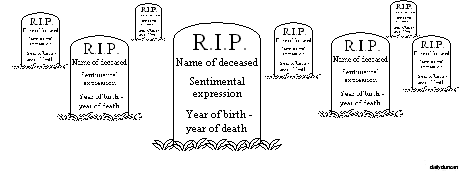No one knows exactly what happens to our consciousness when we die, but we do know what happens to our bodies: they rot. Flesh festers and decays, bone and sinew dissolve and the elements that once formed us are cycled back into the Earth. At least that’s what happens if we don’t interfere with the natural process.
Humans have always been fascinated with death, particularly death of those of our species. Because of this fixation, and also our attachment to those who have departed the world of the living, death rituals are an important practice in every culture.
A death ritual is a ceremony held shortly after the death of a member of society, which honors and commemorates their life through speech, dance or song.
The precise purpose of a death ritual can vary, but they are generally viewed as a sort of final farewell that releases a soul into the afterlife, honors the life of the deceased and offers closure to those left behind. Although these ceremonies share common purposes, their executions are unique and can be shocking to the unfamiliar.
The preparation of the body may involve a number of different customs, including dismemberment, mummification or even applying makeup and dressing it in fine clothing. The final ceremony may involve burying, burning or eating the corpse. Many of these customs seem vile and heretical to Western folk, for we predominantly bury our loved ones and seldom interact with the body. What’s interesting is that of all the ways to dispose of a dead body, burial in a marked grave is the only unsustainable method.
By assigning a small plot of land to each person, every member of society receives a shrine in their honor. Each grave is marked with a stone that bears a brief inscription epitomizing the person’s values and accomplishments. Because of our respect for the dead, these memorials are expected to remain undisturbed. However, this practice cannot continue indefinitely. Eventually our cemeteries will fill, requiring that we devote more and more land to those unable to appreciate our efforts.
This isn’t a threat that many are worried about, since cemeteries now occupy only a very small portion of developed land, which is only a fraction of the 150,000,000 square kilometers of land on our planet, but at some point we must address this issue.
Allowing for reasonable spacing between graves, each plot would require about 6 square meters, which means that the Earth could accommodate around 25,000,000,000 graves. If we inaccurately assume that our population and annual mortality rate remain constant, at 7,000,000,000 and .86% respectively, and that burial soon becomes the official worldwide death ritual, it will be a short 446 years before the entire globe is transformed into a graveyard.
It’s possible that the reason we abandon our world and take to the stars in search of a new home won’t be war, pollution or overpopulation (at least in the conventional sense), but that this planet’s overrun by the remains of our ancestors. It’s true that 2459 is a long way off, and that things could change by that time, but we could be losing 336,000,000 square meters of land every year – land that could be used to benefit the living.
Rather than fearing that the dead rise from their graves, perhaps we should fear that they remain there.
